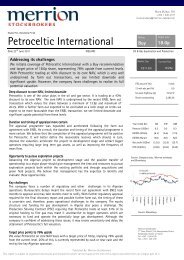Quarterly Bulletin Q3 2013
Quarterly Bulletin Q3 2013
Quarterly Bulletin Q3 2013
You also want an ePaper? Increase the reach of your titles
YUMPU automatically turns print PDFs into web optimized ePapers that Google loves.
Developments in the International<br />
and Euro Area Economy<br />
<strong>Quarterly</strong> <strong>Bulletin</strong> 03 / July 13<br />
63<br />
United Kingdom<br />
According to the Office of National Statistics, the<br />
UK economy expanded by 0.3 per cent during<br />
the first quarter of <strong>2013</strong>. The increase in economic<br />
output during this period was due to higher levels<br />
of household consumption along with changes in<br />
inventories. Meanwhile, net exports, government<br />
consumption, and business investment acted as<br />
a drag on economic growth. Recent sentiment<br />
data point to a further expansion in output during<br />
the second quarter of <strong>2013</strong>. The services PMI<br />
remains above 50 and has displayed further<br />
positive momentum during the second quarter.<br />
The manufacturing PMI has reversed most of the<br />
decline witnessed in February and March and at<br />
53.8 is just short of the 21 month-high reached<br />
in January. Retail sales increased by 1.9 per cent<br />
on an annualised basis in May and were up by<br />
2.1 per cent compared with April. The OECD’s<br />
May Economic Outlook projects that GDP growth<br />
in <strong>2013</strong> will be 0.8 per cent (Table 1), while the<br />
European Commission has a slightly lower outturn<br />
for this year at 0.6 per cent. Both see stronger<br />
prospects for 2014 at 1.5 and 1.7 per cent<br />
growth, respectively.<br />
The Consumer Price Index recorded an annual<br />
increase of 2.7 per cent in May, up from 2.4 per<br />
cent in April. Since October last year, annual<br />
inflation has remained between 2.7 and 2.8 per<br />
cent with the exception of the temporary dip<br />
recorded in April. The largest contribution to the<br />
latest increase in inflation came from transportation<br />
and this was partially offset by developments in<br />
food prices. The Bank of England’s May Inflation<br />
Report projects that inflation should fall below<br />
2 per cent towards the end of 2015 as external<br />
price pressures wane and a revival of productivity<br />
growth is experienced.<br />
No changes have been made by the Bank of<br />
England’s Monetary Policy Committee (MPC) to<br />
the bank rate – which remains at 0.5 per cent – or<br />
to the asset purchases programme since the start<br />
of the year. Net lending by banks participating<br />
in the Bank of England’s Funding for Lending<br />
Scheme remained negative during the first quarter<br />
of <strong>2013</strong> at -£300 million but less than the figure of<br />
-£2.4 billion recorded during the fourth quarter of<br />
2012. During the March budget, the Chancellor<br />
reaffirmed that monetary policy should be set<br />
to meet the 2 per cent inflation target but in a<br />
65.0<br />
60.0<br />
55.0<br />
50.0<br />
45.0<br />
40.0<br />
35.0<br />
30.0<br />
Chart 9: PMI Indicators for the UK<br />
Jan<br />
Mar<br />
May<br />
July<br />
Sep<br />
Nov<br />
Jan<br />
Mar<br />
May<br />
July<br />
Sep<br />
Nov<br />
Jan<br />
Mar<br />
May<br />
July<br />
Sep<br />
Nov<br />
Jan<br />
Mar<br />
May<br />
July<br />
Sep<br />
Nov<br />
Jan<br />
Mar<br />
May<br />
UK Manufacturing PMI<br />
Source: Markit.<br />
way that avoided undesirable volatility in output.<br />
The new remit also confirmed that the MPC<br />
should promote understanding of the trade-offs<br />
inherent in setting monetary policy to meet a<br />
forward looking inflation target while giving due<br />
consideration to output volatility.<br />
The UK economy still faces a number of<br />
challenges at it attempts to re-balance economic<br />
activity away from consumer spending and<br />
towards investment and exports. The persistent<br />
weakness in economic activity across the euro<br />
area – the UK’s largest trading partner – limits the<br />
scope for export growth. Total unemployment at<br />
7.8 per cent has fallen to its lowest in two years.<br />
Numbers in employment rose to a new high in<br />
April while pay growth has picked up modestly<br />
and job vacancies have shown the largest<br />
increase since late-2010, hitting the highest<br />
since December 2008. At the same time, youth<br />
unemployment (those aged 16-24) remained high<br />
at 20.7 per cent during the first quarter. Finally,<br />
the on-going fiscal consolidation acts as a drag on<br />
short term growth.<br />
Japan<br />
UK Services PMI<br />
July<br />
Sep<br />
Nov<br />
Jan<br />
Mar<br />
May<br />
2008 2009 2010 2011 2012 <strong>2013</strong><br />
Note: For PMI indicators, above 50 represents expansion, below<br />
50 represents contraction.<br />
Real GDP grew by 1.0 per cent in Japan<br />
during the first quarter of <strong>2013</strong>, up from 0.3 per




